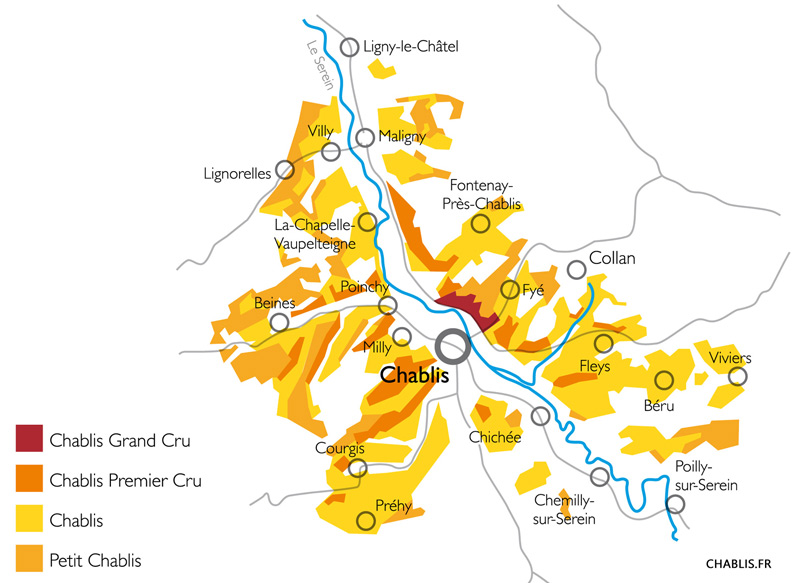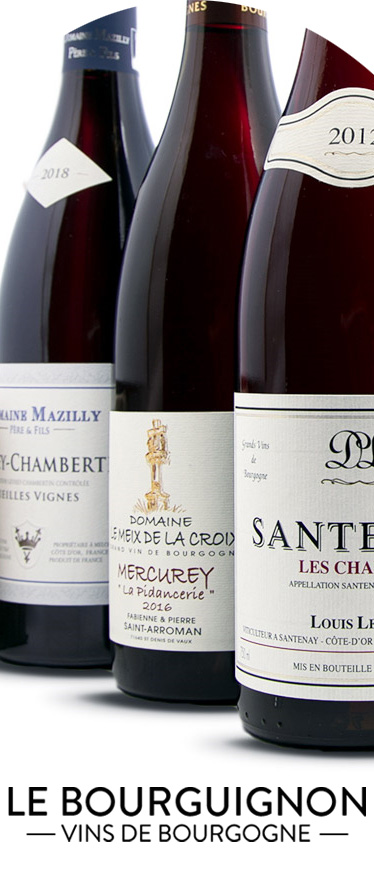Le Petit Chablis is part of the Chablis vineyard, in the Yonne department (89), with an area of 782.71 hectares, on both sides of the Serein valley.
The Petit Chablis is a controlled designation of origin, created in 1944, it dreams of being called Chablis Villages or Côte de Chablis, which is to this day refused. This appellation can be produced in all the communes of the Chablis vineyards.
In Burgundy, it is the parcels of vines that are delimited into appellation areas. It is therefore a geographical principle that dominates first. Thus, over time, a classification by geographical origin has been created on "3 levels" of the AOC.
- Regional appellations (red Burgundies, white Burgundies, Burgundy Côte d'Auxerre…)
- Petit Chablis and Chablis, appellations villages and Chablis Premier Cru, appellation village Premier Cru
- Chablis Grand Cru, the third level of appellation (Blanchot, Bougros, Les Clos, Grenouilles, Les Preuses, Valmur and Vaudésir)
Petit Chablis and Chablis are therefore both Village level appellations .
What is the difference between Petit Chablis and Chablis?
It is mainly the geology, the exposure of the plots and the proximity to the city of Chablis that determines the areas of appellations (as you can see on the map of the Chablis vineyard. Source: Chablis.fr). 
Geology
The Chablis vineyard is located on the outskirts of the vineyard or on the plateaus, outside the limits of the more prestigious AOCs such as Chablis and Chablis Grand Cru. For the most part, the vines are between 230 and 280 meters above sea level and are of various exposures .
The subsoil is composed of limestones of the Tithonian (the former Portlandian) for the plateaus and marls of the Kimmeridgian for the hillsides.
- The limestones of the Tithonien are mainly found on the plateaus of the appellation. It is a soil that is not very calcareous, marly and has no fossils. It produces wines with more fruity characteristics and have little minerality.There is most often the Petit Chablis.
- The Kimmeridgian marls are mainly found in the south-eastern sector of the appellation and go up to the village of Chablis. This soil has very compact limestone layers as well as clay marls containing in abundance fossilized marine organisms in this case tiny oysters (exogyra virgula). These marine sediments brought by the sea 150 million years ago give us the typicity of Chablis wines.
What winemakers fear are white frosts and ice frosts in spring or hailstorms in summer, which can lead to a loss of significant crops. In order to combat frost, winemakers warm the vine by all kinds of means such as candles.
Tasting
Petit Chablis exists only in white wine, made from the Chardonnay grape variety (locally called Beaunois).
During the harvest , these grapes are recognized by their small size, cylindrical, irregular, golden yellow in color. The sugar contents of the berries can reach high levels while maintaining a significant acidity, which makes it possible to obtain particularly well-balanced, powerful and ample wines with a lot of fat and volume.
The Petit Chablis offers a pale gold color, shining with greenish reflections, its nose is open even young, and evokes aromas of flowers, citrus, slightly iodized with a feeling of minerality (flint, gun stone). On the palate we will find a lively wine with a very beautiful acidity and a beautiful length, a wine with a lot of elegance and finesse.
The Petits Chablis are very pleasant to enjoy at the time of the aperitif with seafood, goat cheese, or snails of Burgundy, a nod to the region.
These are wines of pleasure with excellent value for money. Their ideal serving temperature as an aperitif is 8°C and 9 to 10°C with a meal. Petit Chablis can be easily enjoyed in the year following the harvest.

